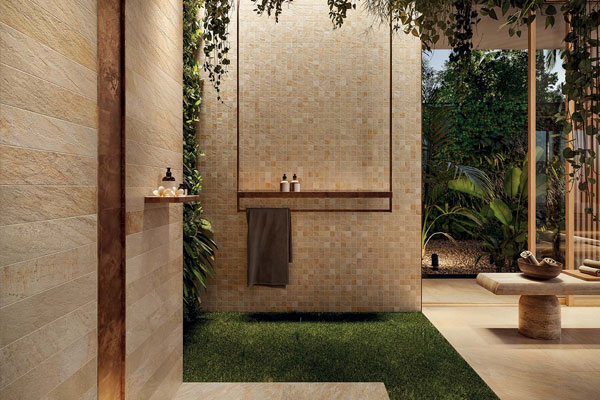
Today’s bathrooms not only have to cope with humidity, but also with aggressive cleaners, modern shampoos and chemical soaps that can damage floors, counters and walls. If properly sealed, porcelain stoneware tiles are non-porous and can withstand this type of harsh environment perfectly. However, regular maintenance is necessary to prolong their life and shine.
Cleaning tiles after initial installation
For a tiled floor that looks its best and is clean, it is necessary to remove all traces of mortar that settle on the surface of the tiles during grouting. Poorly removed grout residues can leave rings that are difficult to remove afterwards and create an absorbent film on the surface, making it easier for all kinds of dirt to adhere and giving the impression that your tiles are still stained.
The whitish film left on the surface, also known as grout veil, can be easily removed with a commercial cement veil remover or made at home with white vinegar and warm water. If your tiles were installed within three days, mix one part vinegar to four parts water. If your tiles were installed within five to ten days, mix two parts vinegar to three parts water.
How do you maintain your tiles every day?
Tiling is a timeless and sensible choice for bathrooms. Flooring options such as linoleum and laminate don’t offer the same level of protection against water damage as porcelain stoneware tiles.
To discover tiles for the bathroom, Novoceram offers a wide choice of highly resistant and modern tiles. They can withstand a hot, soapy environment and are easy to clean with natural, inexpensive products. What’s more, they’re durable and won’t release volatile organic compounds into your home.
Whether you choose plain or effect ceramic tiles, such as wood bathroom tiles or stone or concrete effect tiles, you should know that they are all perfectly resistant to damp. But once they’ve been installed, it’s a good idea to look after them to preserve their initial shine and extend their lifespan. This involves regular dry cleaning with a hoover or broom, damp cleaning with a floorcloth, and deep cleaning of the tiles if necessary, for the most stubborn stains.
Here are our tips and tricks for making your bathroom tiles last forever
Tiny particles of dust can act like sandpaper on some of the finishes on your tiled floors. So it’s important to sweep regularly and use frequent mats at entrance doors to reduce the amount of dust that can enter the house. Using felt protectors under furniture legs and carpets in high-traffic areas can also reduce the amount of scratching.
If you opt for a commercial cleaning product, be aware that tiled floors should be cleaned with a special product for grout and tiles. Textured tiles may require light scrubbing. Never use a detergent with soap or wax in the ingredients, as it will leave a film on the tile, trapping the dirt.
Bleach- and ammonia-based cleaners can discolour your tiles if used in large quantities. That’s why it’s advisable, once you’ve chosen the right cleaning solution for your tiles, to try a test patch in an inconspicuous area to make sure there’s no damaging effect and to stick to the dosages prescribed by the manufacturer.
FAQs on cleaning bathroom tiles
Here are our answers to the most common questions you may have about cleaning your bathroom tiles:
How can I effectively remove mould from the joints of my tiles?
The aim is to successively remove the surface layers of mould to reach the deepest roots. Beware of using bleach, which can encourage mould to take root even deeper. Even if they disappear temporarily, they will be harder to dislodge when they reappear.
Don’t scrape the mouldy area dry either, to avoid spreading the spores into the air. Use a sponge soaked in water and black soap or Marseille soap to clean the mouldy area, then rinse and dry with a cloth to be put through the washing machine.
I have traces of limescale on my bathroom tiles. How can I remove them?
Limescale is naturally present in water to a greater or lesser extent depending on the region. To remove it, simply soak your porcelain stoneware tiles in lemon juice and vinegar overnight and clean them with clear water the next day.
Alternatively, mix equal parts bicarbonate of soda and vinegar to make a thick paste and spread over the affected area of the tiles. Leave the solution to stand for 10 to 15 minutes. Gently rub the tiles and grout lines with a sponge or toothbrush, then rinse the surface with clean, fresh water.
How often should I clean my modern bathroom tiles?
It’s generally recommended that you thoroughly clean all your bathroom tiles once a week, as germs, mould and scum can quickly build up. It’s thought that viruses can survive on bathroom surfaces for up to a week.
So not cleaning them regularly can lead to infections and respiratory illnesses. Don’t forget to clean the light switch and door handle, two items that are often overlooked!




